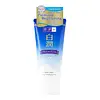What's inside
What's inside
 Key Ingredients
Key Ingredients

 Benefits
Benefits

 Concerns
Concerns

 Ingredients Side-by-side
Ingredients Side-by-side

Water
Skin ConditioningButylene Glycol
HumectantSodium Myristoyl Glutamate
CleansingSorbitol
HumectantSodium Lauroyl Glutamate
Sodium Methyl Cocoyl Taurate
CleansingCocamide DEA
EmulsifyingMyristic Acid
CleansingSodium Chloride
MaskingLauric Acid
CleansingPEG-40
HumectantHydrogenated Castor Oil
EmollientGlyceryl Stearate
EmollientPEG-100 Stearate
Hydroxyacetophenone
AntioxidantPolyglycerin-6
HumectantCitrus Paradisi Peel Oil
MaskingCitrus Aurantium Dulcis Peel Oil
MaskingMoringa Oil/Hydrogenated Moringa Oil Esters
Skin ConditioningGlycerin
HumectantArbutin
AntioxidantPhytic Acid
Sodium Hyaluronate
HumectantCeramide AP
Skin Conditioning1,2-Hexanediol
Skin ConditioningAngelica Polymorpha Sinensis Root Extract
Skin ConditioningBiosaccharide Gum-4
Skin ConditioningSodium Acetylated Hyaluronate
HumectantBletilla Striata Root Extract
Skin ConditioningMorus Alba Bark Extract
Skin ConditioningPaeonia Albiflora Root Extract
Skin ConditioningAmpelopsis Japonica Root Extract
Skin ConditioningAtractylodes Macrocephala Root Extract
Skin ConditioningPerilla Frutescens Leaf Extract
MaskingPoria Cocos Extract
Skin ConditioningSyringa Oblata Bark/Leaf Powder
AbrasivePhenoxyethanol
PreservativeMoringa Oleifera Seed Extract
Skin ConditioningDisodium Phosphate
BufferingCitric Acid
BufferingHydroxypropyltrimonium Hyaluronate
Methylparaben
PreservativeWater, Butylene Glycol, Sodium Myristoyl Glutamate, Sorbitol, Sodium Lauroyl Glutamate, Sodium Methyl Cocoyl Taurate, Cocamide DEA, Myristic Acid, Sodium Chloride, Lauric Acid, PEG-40, Hydrogenated Castor Oil, Glyceryl Stearate, PEG-100 Stearate, Hydroxyacetophenone, Polyglycerin-6, Citrus Paradisi Peel Oil, Citrus Aurantium Dulcis Peel Oil, Moringa Oil/Hydrogenated Moringa Oil Esters, Glycerin, Arbutin, Phytic Acid, Sodium Hyaluronate, Ceramide AP, 1,2-Hexanediol, Angelica Polymorpha Sinensis Root Extract, Biosaccharide Gum-4, Sodium Acetylated Hyaluronate, Bletilla Striata Root Extract, Morus Alba Bark Extract, Paeonia Albiflora Root Extract, Ampelopsis Japonica Root Extract, Atractylodes Macrocephala Root Extract, Perilla Frutescens Leaf Extract, Poria Cocos Extract, Syringa Oblata Bark/Leaf Powder, Phenoxyethanol, Moringa Oleifera Seed Extract, Disodium Phosphate, Citric Acid, Hydroxypropyltrimonium Hyaluronate, Methylparaben
 Reviews
Reviews

Ingredients Explained
These ingredients are found in both products.
Ingredients higher up in an ingredient list are typically present in a larger amount.
Cocamide DEA is a coconut-derived cleansing agent that creates rich foam and helps to thicken the consistency of cleansing products.
This ingredient effectively removes dirt and oil while helping to stabilize formulations, making it a common addition to shampoos, body washes, and facial cleansers.
It has become less popular in recent formulations due to potential irritation in sensitive skin types and concerns about trace amounts of diethanolamine (DEA), which can potentially form nitrosamines.
While still considered safe at regulated concentrations, many manufacturers now opt for gentler alternatives like cocamidopropyl betaine or other surfactants that offer similar benefits with fewer potential drawbacks.
Learn more about Cocamide DEAGlycerin is already naturally found in your skin. It helps moisturize and protect your skin.
A study from 2016 found glycerin to be more effective as a humectant than AHAs and hyaluronic acid.
As a humectant, it helps the skin stay hydrated by pulling moisture to your skin. The low molecular weight of glycerin allows it to pull moisture into the deeper layers of your skin.
Hydrated skin improves your skin barrier; Your skin barrier helps protect against irritants and bacteria.
Glycerin has also been found to have antimicrobial and antiviral properties. Due to these properties, glycerin is often used in wound and burn treatments.
In cosmetics, glycerin is usually derived from plants such as soybean or palm. However, it can also be sourced from animals, such as tallow or animal fat.
This ingredient is organic, colorless, odorless, and non-toxic.
Glycerin is the name for this ingredient in American English. British English uses Glycerol/Glycerine.
Learn more about GlycerinWater. It's the most common cosmetic ingredient of all. You'll usually see it at the top of ingredient lists, meaning that it makes up the largest part of the product.
So why is it so popular? Water most often acts as a solvent - this means that it helps dissolve other ingredients into the formulation.
You'll also recognize water as that liquid we all need to stay alive. If you see this, drink a glass of water. Stay hydrated!
Learn more about Water